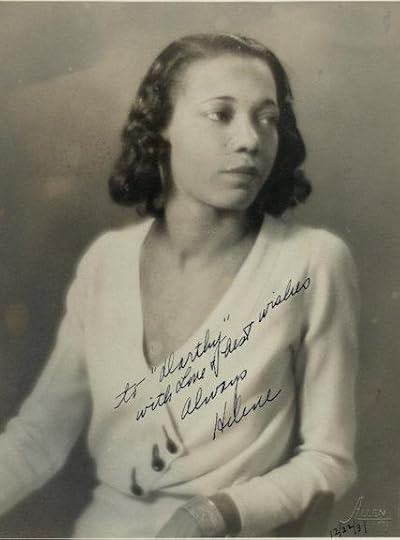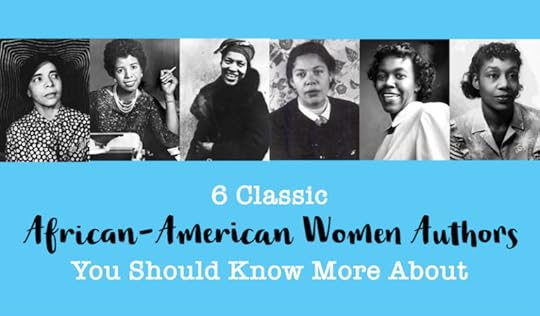Helene Johnson
Helen Johnson (July 7, 1906 – July 6, 1995) later nicknamed Helene, was an African-American poet during the Harlem Renaissance era, born in Boston and raised in Brookline, Massachusetts. Shortly after her birth, her father left, leaving her to be raised by her mother, Ella, and grandfather, Benjamin Benson, who was born into slavery.
Helene Johnson grew up surrounded by her mother and aunts, a group of strong women who later influenced her strong voice in poetry. She was also the cousin to novelist and short-story writer Dorothy West.
While living in Brookline, Johnson joined the Saturday Evening Quill Club and won a short story contest in the Boston Chronicle. She later continued on to attend classes at Boston University, but never graduated. The themes of Johnson’s poems are often viewed as erotic, exploring the gender and racial politics of the 1920’s Harlem Renaissance. “Bottled” is one of her most famous poems, published in 1927 in the May issue of Vanity Fair.
Rise to recognition
Johnson began publishing poetry in African-American magazines such as the NAACP’s The Crisis, which was founded in 1910 and edited by W.E.B. Du Bois. She began to attract attention when she was published in Opportunity: A Journal of Negro Life in 1925 when she was 19 years-old. A year later, the journal published six of her poems.
Her work was in the first and only issue of Fire, a publication edited by Langston Hughes, a driving force himself during the Harlem Renaissance.
This photo of Helene Johnson is inscribed to “Dorothy,”
presumably Dorothy West, her cousin
Johnson and her cousin, Dorothy West, were drawn to the energy of Harlem in the 1920’s. In 1927, the two moved to New York, and enrolled in classes at Columbia University, eventually developing a friendship with writer and anthropologist Zora Neale Hurston.
Johnson became deeply engrossed in the struggles of the economic and racial divide in Harlem, and wrote passionately about these issues. She was later described as a writer who “… combines an expression of unquenchable desires with realistic description of ghetto life and a discovery of the roots of her people.”
Although she didn’t graduate from Columbia, Johnson’s talent earned praise from her professors, and she was compared in form and style to Langston Hughes.
Motherhood and marriage a priority
In 1933 Johnson’s dreams of motherhood and family came true when she married William Hubbell. In 1935, her last published poems appeared in Challenge: A Literary Quarterly. She focused her attention and time on their daughter, Abigail. She and Hubbell later divorced.

You might also like: 12 Women Writers of the Harlem Renaissance
“Ah My Race”
Readers began to take notice when Johnson’s poem “Bottled” containing innovative slang and unconventional rhythms was published in Vanity Fair, in the May edition of 1927. A similar piece is reproduced here, a short poem called “Ah My Race”:
Ah my race,
Hungry Race,
Throbbing and young–
Ah, my race,
Wonder race,
Sobbing with song,
Ah, my race,
Careless in mirth, Ah, my veiled race, Fumbling in birth
Powerful female voice
Although described as being a painfully shy child, her voice blossomed in poetry. Much of Johnson’s upbringing inspired her poetry, when she became independent at an early age. Her poetry conveys a powerful female perspective and influence. Her 1925 poem, “Ah My Race” boldly challenges the feminine themes of love and motherhood. Poet Rita Dove said of her work:
“Helene Johnson proved herself a lyricist of utmost delicacy yet steely precision; restraint attends her every meditation on love, race and loss.”
Helene Johnson was a brilliant yet under-appreciated woman poet of the Harlem Renaissance, partly in part to her disappearance from the literary scene after she started her family. Johnson valued the working class and took pride in their accomplishments, capturing in her poetry the voice and rhythms of the streets of Harlem.
Much of her poetry was written for her own interest and pleasure, with little intention to be published. Indeed, there are no published collections of her works; they are scattered among journals and magazines.
After her last published work appeared in Challenge: A Literary Quarterly, it is believed that she continued to write at least one poem every day for the rest of her life.
Johnson died in her Manhattan home at the age of 89.
6 Classic African-American Women Authors You Should Know More About
More information
Wikipedia
My Poetic Site
Helene Johnson, Poet of Harlem, 89, Dies
Goodreads: Helene Johnson
Selected works
“Trees at Night” – Opportunity (May 1925)
“Night” – Opportunity (January 1926)
“Metamorphism” – Opportunity (March 1926)
“Fulfillment” – Opportunity (June 1926)
“Fiat Lux” – The Messenger (July 1926)
“The Little Love” – The Messenger (July 1926)
“Futility” – Opportunity (August 1926)
“Mother” – Opportunity (September 1926)
“Love in Midsummer” – The Messenger (October 1926)
“Magula” – Palms (October 1926)
“Bottled” – Vanity Fair (May 1927)
“Poem” – Caroling Dusk (1927)
”Sonnet to a Negro in Harlem” – Caroling Dusk (1927)
“What Do I Care For Morning” – Caroling Dusk (1927)
“A Missionary Brings a Young Native to America” – Harlem (November 1928)
“Cui Bono?” – Harlem (November 1928)
“I Am Not Proud” – Saturday Evening Quill (April 1929)
Biography
This Waiting for Love: Helene Johnson, Poet of the Harlem Renaissance, Mitchell, Verner D. ed. 2000
*This post contains affiliate links. If the product is purchased by linking through, The Literary Ladies Guide receives a modest commission, which helps maintain our site and helps it to continue growing!
The post Helene Johnson appeared first on Literary Ladies Guide.





